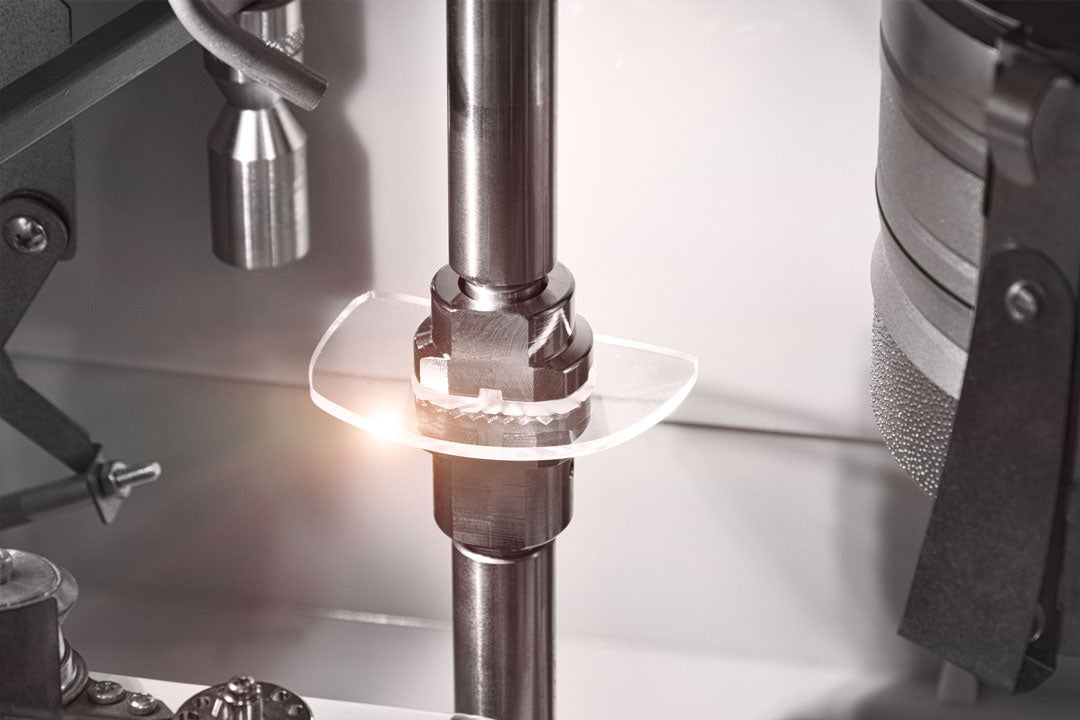"High index lenses are a type of eyeglasses lens which have a high "index" of refraction. This means they can refract light more efficiently, allowing them to be thinner and lighter than 'standard index' lenses."
Spectacle lenses can indeed differ in dioptric strength. But they can also differ in refractive index which measures how efficiently the lenses can bend light.
When light enters any type of spectacle lens, it slows down and bends at an angle within the lens material. This effect is known as refraction. The more efficiently the light is bent, the higher the index of refraction.
Low index lenses are less refractive. Light is only slightly bent, thus taking longer to pass through. For strong prescriptions, your lenses have to be thicker to sufficiently refract the light which can become problematic in terms of weight and aesthetics.
High index lenses are more refractive. Light is bent more severely, thus being much quicker to pass through. Less material is required to achieve the same amount of refraction thus making your lenses thinner and lighter in weight.
As a rule of thumb, lenses with an index of 1.50 or more are considered as “high index.” There are various indexes of lenses available (depending on the brand) however they generally follow the same pattern of increments as listed further below.
What are the different indexes of lenses?
- 1.50 = 'standard index'
- 1.60 = thinned
- 1.67 = super thin
- 1.74 = ultra thinned

Should I upgrade to high index lenses?
Upgrading to high index lenses depends on your individual needs and preferences. If you have a strong prescription and are looking for thinner and lighter lenses, then high index lenses may be a great option for you. They can also provide better aesthetics as they reduce the overall weight and bulk of your frame.
Additionally, high index lenses are a good option for those who have a higher prescription and need strong vision correction. Thick lenses can cause distortion in peripheral vision due to the magnification effect. High index lenses can help minimize this issue by reducing the thickness of the lens.
However, if you have a low or moderate prescription, upgrading to high index lenses may not be necessary as they will only provide minimal benefits in terms of weight and aesthetics. Too often do people pay for an index of lens with a marginally thinner or lighter profile.
How do I know if I need high index glasses?
The stronger your prescription is, the higher index lenses you'll need. But as this is based on various factors such as your prescription's Sphere, Cylinder and Addition. This is why it can be a little confusing which index is right for you.
To make things easier, I’ve made a handy table (further below) which you can use to see which lens index you should be aiming for. The table is to be used as general guidelines which can help you avoid having overly thick “milk bottle” lenses. Equally, this advice can prevent you from paying for lens thinning when it isn’t really required for your prescription.
|
|
Dioptre |
1.5 |
1.60 |
1.67 |
1.74 |
|
Index |
|
|
|
|
|
|
+6.00 |
Approx. thickness |
8.3 mm |
7.1 mm |
6.4 mm |
5.1 mm |
|
+4.00 |
Approx. thickness |
5.7 mm |
5 mm |
4.3 mm |
3.6 mm |
|
+2.00 |
Approx. thickness |
3.3 mm |
2.9 mm |
2.8 mm |
2.6 mm |
|
|
|
|
|
|
|
|
-2.00 |
Approx. thickness |
4.8 mm |
3.6 mm |
3.3 mm |
2.9 mm |
|
-4.00 |
Approx. thickness |
7.6 mm |
5.9 mm |
5.3 mm |
4.2 mm |
|
-6.00 |
Approx. thickness |
10.3 mm |
7.9 mm |
7.3 mm |
5.9 mm |
|
-10.00 |
Approx. thickness |
16.9 mm |
13.4 mm |
12 mm |
9.7 mm |
At what prescription are high index lenses recommended?
If your Sphere power is stronger than +/- 4.00 diopters, or your Cyl power is stronger than +/- 2.00, then high index lenses are typically recommended. To help, why not compare your prescription to table above see which index is best suited for you?
What are the advantages of high index lenses?
#1 No 'bug eyes' for you
High index lenses have less of a 'magnifying effect' on your eyes. This is purely aesthetic, but prevents your eyes looking larger then they actually are.
#2 Slimmer lenses
High index lenses are more efficient at letting light pass through, so they can be made thinner compared to standard index lenses. If you have a particularly strong minus Sphere, a high refractive index will help to prevent the edges of your lenses from protruding from your frame.
#3 Lighter frame
High index lenses are also lighter. Subsequently, this makes your glasses frame more comfortable to wear as it reduces their overall weight. We’re only talking a few grams here, but it can really help to reduce their pressure on your face and hopefully stop them from slipping down your nose.
#4 Flatter & prettier
High index lenses can also be made in what's called as Aspheric design, meaning the lens has been made to a flatter profile than a Spheric equivalent. This further prevents the lenses from being overly thick with the benefit of reduced peripheral distortion.
What are the disadvantages of high index lenses?
#1 Higher cost
The main disadvantage of high index lenses is their higher cost compared to standard index lenses. Due to the more advanced technology and raw materials used, these lenses tend to be more expensive. Furthermore, these lenses have a higher demand due to their aesthetic appeal therefore a higher price can be charged. As a rule of thumb, the higher the index of the lenses, the higher the cost.
#2 Increased reflection
Despite their advantageous refraction, high index lenses are prone to being more reflective than standard index equivalents. For you, anti-glare coating is crucial to avoid any distracting/annoying reflections across your lenses, especially at night. This upgrade improves your visual acuity as more light can pass through your lenses. This coating also helps with eye contact, as people can see your eyes more clearly.
#3 Vision distortion
Resulting from a higher refractive index and thinner lens profile, high index lenses can cause more visual distortion - especially in your peripheral vision. In optics, this is known as aberration, or abbe for short and affects all optical lenses regardless of their refractive index.
To avoid this, accurate alignment of your pupil behind your lenses is important to reduce the chances of peripheral distortion through your lenses. This is achieved through proper centration by horizontally and vertically aligning your eyes behind the optical centre of each lenses.
When ordering glasses online, you can help to avoid unnecessary distortion by providing your pupillary distance and providing your ocular heights when ordering your lenses.
#4 More Brittle
High index lenses aren't as strong than standard index equivalents. Their lesser impact resistance makes then more brittle and susceptible to shattering. If you play contact sports or have a physically demanding occupation, you may prefer to choose high index lenses made from polycarbonate or Trivex which offer greater durability and impact resistance.

Why are high index lenses so expensive?
High index lenses are more expensive due to the materials and manufacturing processes involved, plus market forces such as their aesthetic appeal and subsequent demand. The higher refractive index substrate materials used in these lenses are more costly to produce, resulting in a higher price point for the end product.
Lastly, high index lenses are more desirable due to their aesthetic qualities, reduced bulk and lighter weight. In turn, this attracts many glasses wearers who wish to have sleek, nice looking glasses that don't magnify the look of their eyes. This demand raises the retail prices of high index lenses as a higher price can be charged.
However, the benefits of high index lenses make them worth the investment. They provide thinner and lighter lenses with superior optical clarity, making them a popular choice if you have a strong prescriptions. Plus, with proper care and handling, these lenses can last just as long as standard index lenses, making them a cost-effective option in the long run.
High index lenses thickness chart
The difference in thickness between the various lens indexes depends on various factors such as your prescription, your pupillary distance and the size of your glasses frame. However, to get an idea of lens thickness per index, check out the handy chart below.

Is there a big difference between 1.67 and 1.74 high index lenses?
The average difference in thickness between 1.67 and 1.74 high index lenses is about 16%. If you have a Sphere of +/-9.00 or a Cyl of +/-4.00 then 1.74 index lenses is certainly the best option to keep your lenses thinner, flatter and lighter in weight.
Do high index lenses make eyes look bigger?
High index lenses reduce the effects of positive or negative magnification which can make your eyes look either bigger or smaller . This is especially beneficial if you have a stronger prescription, as thicker lenses can magnify and distort the size of the eyes. Better still, high index lenses with an Aspheric or even a Double Aspheric profile can reduce the side-effect of your eyes looking bigger or smaller.
Is 1.50 astigmatism high?
A dioptric Cylinder (Cyl) value of 1.50 on your prescription paper is generally considered as mildly astigmatic. Less than 1.50 is very mild whereas above 1.50 indicates a strong degree of astigmatism. Astigmatism is a common vision condition that causes blurred vision due either to the irregular shape of the cornea or sometimes the curvature of the lens inside the eye. It's not a disease, rather it's simply a variation from normal spherical curvature.
If your prescription indicates a Cyl value of 1.50, this means you have a slight deviation from a perfectly spherical curvature in your eye, which can cause images to appear stretched, blurry, or distorted. However, this is quite mild and can usually be easily corrected with the right lenses.
How much does it cost for high index lenses?
At Banton Frameworks, we offer free prescription lenses with every release of our handmade spectacles and sunglasses (just 6 times a year). However, various upgrades including lens thinning, coatings and tints may be added. To calculate the cost of your lenses, why not check out our handy lens calculator.
Key takeaways
- Index refers to refractive index
- The stronger the index, the better a lens can bend light
- 1.50 index lenses are considered 'standard index'
- 1.60 to 1.74 lenses are considered 'high index'
- The stronger your prescription, the higher the index you need
- The higher the index, the higher the cost
- High index lenses are thinner, lighter and flatter but also cost more and are more fragile than standard index equivalents
- Always invest in anti-glare coatings to reduce reflections for high index lenses
- Consider Polcarbonate or Trivex lens materials if you need high impact resistance
Hopefully you found this article helpful. Please check out our other eyecare blogs. Thanks for stopping by.
